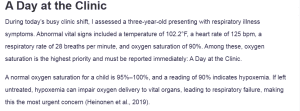A Day at the Clinic
During today’s busy clinic shift, I assessed a three-year-old presenting with respiratory illness symptoms. Abnormal vital signs included a temperature of 102.2°F, a heart rate of 125 bpm, a respiratory rate of 28 breaths per minute, and oxygen saturation of 90%. Among these, oxygen saturation is the highest priority and must be reported immediately: A Day at the Clinic.
A normal oxygen saturation for a child is 95%–100%, and a reading of 90% indicates hypoxemia. If left untreated, hypoxemia can impair oxygen delivery to vital organs, leading to respiratory failure, making this the most urgent concern (Heinonen et al., 2019).
Other significant observations to help the RN address the priority concern include nasal flaring, retractions, cyanosis, and grunting associated with respiratory distress. In addition, the child’s cough can be described as productive, dry, or wheezing in nature. The child’s behavioral changes, such as lethargy or irritability, may give significant contextual cues (Weekley & Bland, 2023).
Confirmatory signs of necessity for urgent intervention and supplementation with oxygen will be lip or peripheral cyanosis, noisy breathing, and labored respiratory effort. The abnormal vital signs deviate from the normal ranges:
- Temperature: 97.9°F–100.4°F; the child’s is 102.2°F.
- Heart rate: 80–120 bpm; the child’s is 125 bpm.
- Respiratory rate: 20–25 breaths/min; the child’s is 28.
- Oxygen saturation: 95%–100%; the child’s is 90%.
The first treatment would be supplemental oxygen to improve oxygen saturation and stabilize breathing. Once oxygenation is restored, antipyretics such as acetaminophen can be administered to reduce the fever, which may also help lower the elevated heart rate. Hydration support would also be important for overall recovery (Heal et al., 2022).
Additionally, the mother’s report of her four-month-old baby having sniffles is concerning, given the infant’s young age and immature immune system. Infants are highly susceptible to severe respiratory infections, such as RSV, which can compromise feeding and breathing. The baby should be evaluated for rapid breathing, nasal congestion, poor feeding, and retractions to prevent complications.
References
Heal, C., Harvey, A., Brown, S., Rowland, A. G., & Roland, D. (2022). The association between temperature, heart rate, and respiratory rate in children aged under 16 years attending urgent and emergency care settings. European Journal of Emergency Medicine, Publish Ahead of Print (6). https://doi.org/10.1097/mej.0000000000000951
Heinonen, S., Rodriguez-Fernandez, R., Diaz, A., Oliva Rodriguez-Pastor, S., Ramilo, O., & Mejias, A. (2019). Infant Immune Response to Respiratory Viral Infections. Immunology and Allergy Clinics of North America, 39(3), 361–376. https://doi.org/10.1016/j.iac.2019.03.005
Weekley, M. S., & Bland, L. E. (2023, July 18). Oxygen Administration. National Library of Medicine; StatPearls Publishing. https://www.ncbi.nlm.nih.gov/books/NBK551617/
ORDER A PLAGIARISM-FREE PAPER HERE
We’ll write everything from scratch
Question 
Purpose of Assignment: To identify risks and treatment options for respiratory illnesses.
Scenario:
You are one of the LPNs on duty at the clinic today. It has been very busy; it is cold and flu season. There have been so many kids in with respiratory illnesses that there is a designated LPN in charge of getting them all checked in. That is your role today: you will be taking vital signs, obtaining weights, and alerting the RN to any child with abnormal vital signs.
Your call the next child back to the treatment room for vital signs and a weight. This little one is three years old. He was brought in by his mom who says he has had a cough and sniffles for two days. Mom is also carrying a baby who she says is four-months-old. Mom says the baby has sniffles too, but she does not think the doctor needs to see the baby. The baby is sleeping when you call back the other child.
This is the data you collected from the three-year-old child:
- Temperature- 102.2 F orally (above normal range)
- Heart rate- 125 (above normal range)
- Blood pressure- 100/60 (within normal range)
- Respiratory rate- 28 (above normal range)
- Oxygen saturation- 90% (below normal range)
- Weight- 28 pounds (within normal range)
Instructions:
Using the above scenario, answer the following questions:
- There are four measurements above that are abnormal and will be reported to the RN. Which measurement has the highest priority and should be reported immediately? Explain your response.
- What additional information will be helpful to report to the RN regarding this priority concern? Explain your response and include what your findings might be.
- There are four vital sign readings that are abnormal. What is the normal range for each finding? What treatments would be anticipated for the oxygen saturation and the temperature? Which treatment will be given first? Explain your response.
- Additionally, since Mom reported that the four-month-old baby has sniffles. Should we be more or less concerned about this based on the child’s age? Explain your response.

A Day at the Clinic
Format:
- Standard American English (correct grammar, punctuation, etc.)
- Logical, original and insightful
- Professional organization, style, and mechanics
- Submit document through Grammarly to correct errors before submission
Submit your completed assignment by following the directions linked below. Please check the Course Calendar for specific due dates.
Save your assignment as a Microsoft Word document. (Mac users, please remember to append the “.docx” extension to the filename.) The name of the file should be your first initial and last name, followed by an underscore and the name of the assignment, and an underscore and the date.